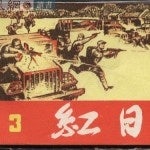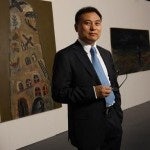Jing Daily’s Top Posts for the Week#
In case you missed them the first time around, here are some of Jing Daily’s top posts for the week of June 27-July 1:

Collector Wang Wei: Art Plays Important Role In Modern Chinese Society
Over the last several years, the Shanghai-based art collector Wang Wei (王薇, previously on Jing Daily) and her husband, billionaire investor and art enthusiast Liu Yiqian, have emerged as perhaps China’s most driven super-collectors, spending tens of millions on contemporary Chinese art, revolutionary-era “Red Classics”, and traditional ink paintings. Recipient of the “Top Collector” nod at this year’s Art Power award ceremony in Beijing, Wang recently announced that she and her husband have finalized plans for a much-discussed private museum to house their collection.
As Wang told Sina this past February, her “Dragon Art Museum” (龙美术馆) will open its doors in November 2012 in Shanghai, featuring contemporary Chinese art on the ground floor, “Red Classics” from 1949-1979 on the second, and traditional works and ancient artifacts on the third floor.

China’s Appetite For Acquisitions Presents Major Opportunities For Mid-Range Brands
Last month, Jing Daily covered the Fosun Group’s plans to acquire a 9.5 percent stake in Greece’s Folli Follie Group for US$121 million, a move that we said reflected the broader interest among Chinese conglomerates to buy up global brands, then re-engineer them with an exclusively China-facing focus. (A model popularized by Ports 1961 owner Kenneth Chan, who moved the company’s operations from Canada to Xiamen after acquiring the brand in 1989.) Similar acquisitions have been seen in recent years in the automotive industry (with Geely’s acquisition of Volvo being the most obvious example), the textile industry, and the fashion industry, where Chinese companies like Li & Fung have recently taken over Western brands like Cerruti.
As Fashion Trend Digest editor Ye Qizheng recently pointed out, mid-range and mass market Western brands are the most attractive for Chinese companies on the hunt for acquisitions, since “these brands can be completely made in China, so there are more options.” As Ye added, “It’s best [for these Western brands] to have a certain domestic reputation and be able to cater to the specific demands of the Chinese market.”

Illy Looks To Grind Away At Starbucks’ Lead In China
Starbucks may get most of the press, but China’s piping hot (pun intended) coffee market is home to dozens of players from at home and abroad, from Japan’s UCC to Columbia’s Juan Valdez to Italy’s illy. Now celebrating its tenth year in mainland China, the 78-year-old illy occupies an interesting niche, comprising a relatively small amount of market share but enjoying a reputation as a more “high-end” brand than many of its competitors.
Via a savvy expansion scheme, which prioritized five-star hotels and upscale restaurants over massive cafe construction or mass-market product lines, illy’s China strategy provides a valuable case study for anyone interested in differentiating a brand in a young but crowded market, in which consumer education remains highly segmented and smart marketing is everything.

Li Guochang: China’s New Collectors Should Build Stronger Arts Culture
As Qian Weipeng, a Shanghai-based dealer, hinted late last month, collecting art is now seen in China as a “must”, either for investment purposes or personal enjoyment. Said Qian, “A lot of coal miners and listed company owners and financiers have built wealth and are comfortable spending it on art”.
The fact that more Chinese “coal miners” and “financiers” are showing up more often at auctions has raised some eyebrows, mostly among those who fear excessive speculation could push the Hong Kong auction market to bubble territory. However, a recent ArtTactic study found that possibility to be remote, noting that short-term speculation could only threaten smaller domestic Chinese auction houses contained within mainland China, and is unlikely to affect the more international Hong Kong market. Still, with so many new collectors getting involved in the market, some of China’s more prominent art aficionados caution that tastes and education need to catch up with demand and enthusiasm in order to foster the development of a healthy and sophisticated collector class. Last week, Li Guochang, chairman of China Forestry Holdings and noted Chinese art collector, said that the country’s collector class now needs a “sense of responsibility” and must focus on content, rather than short-term gain.

Architect Zaha Hadid’s Wangjing “Mountains” Unveiled In Beijing
Last week the Beijing-based real estate giant SOHO China debuted the new showroom for its latest project, Wangjing SOHO, designed by the renowned Iraqi-British architect Zaha Hadid. Set to be completed in 2014, this ambitious project follows on the heels of Hadid’s recently completed Guangzhou Opera House. Described as “a set of aluminum and glass mountains” to be set in Beijing’s Chaoyang district, Wangjing SOHO will consist of three curved office towers ranging in height up to 200 meters, along with three smaller commercial buildings.
SOHO China successfully bid 4 billion yuan (US$618) for the construction site in 2009, announcing at the time that it planned to build approximately 521,000 square meters of gross office and retail space on the land. Wangjing SOHO will be, upon its completion, the first high-rise landmark to be constructed between Beijing Capital International Airport and downtown Beijing.